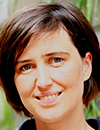07:30 | Conference Registration, Materials Pick-Up, Coffee and Networking in the Exhibit Hall |
|
Conference Plenary Session Takes Place -- Please View Agenda for Plenary Session under the LOACEU2024 Track Agenda Tab |
| |
|
Session Venue: Coolsingel Room |
| |
13:00 | Networking Buffet Lunch in the Exhibit Hall -- Network with Exhibitors and View Posters |
|
Session Title: Advances in Organoid, Spheroid & Organ-on-a-Chip Research, circa 2024 |
| |
|
Session Venue: Coolsingel Room |
| |
14:00 |  | Keynote Presentation Organoids with Reversed Biopolarity (ORBs): SARS-CoV-2 Drug Testing and Breast Cancer Progression
Shuichi Takayama, Professor, Georgia Research Alliance Eminent Scholar, and Price Gilbert, Jr. Chair in Regenerative Engineering and Medicine Wallace H. Coulter Department of Biomedical Engineering, Georgia Institute of Technology & Emory University School of Medicine, United States of America
This presentation will describe production of sub-millimeter diameter, consistent size and shape, lung, kidney, and mammary organoids that have an inverted, apical-out geometry. These Organoids with Reversed Biopolarity (ORBs) are used in 384 well plates in a single-organoid-per-well format to test drugs and disease physiology. The airway ORBs are infected with high yields with multiple SARS-CoV-2 strains with Omicron variant showing highest viral replication and Delta giving the most inflammatory response. The ORBs also predict anti-viral drug efficacy correctly where conventional 2D cultures give false signals. Early-stage breast cancer progression model studies will also be discussed. |
|
14:30 |  | Keynote Presentation CNS Organoid Models for Virus Research
Dasja Pajkrt, Professor of Viral Pediatric Infectious Diseases, Amsterdam University Medical Center, Head OrganoVIR Labs, Netherlands
Virus research historically relies on research using cell lines or animal models. Organoid technology is highly applicable in the virology field, yet unexplored. Organoid systems can mimic the in vivo human physiological environment and provide tools to study human host-virus interactions. The pathogenesis of a variety of human viruses, such as picornaviruses, HIV and human cytomegalovirus (CMV) is increasingly being studied using these novel human organoid models. Human airway epithelium (HAE) cultures and lung organoids allow for host-pathogen interaction studies on viral infections in the respiratory tract (RT), while human gut and brain organoids facilitate human gastro-intestinal tract (GIT) and brain studies. We established human RT (using HAE and lung organoids), GIT (using human gut organoids) and brain (using blood-brain- barrier, whole brain and forebrain organoids) 3D models to study virus infections such as SARS-CoV2, picornavirus, CMV and HIV infections. During the presentation I will share results that are derived from these studies. |
|
15:00 |  | Keynote Presentation Relevant 3D In vitro Models For Predictive Screening of Nanodrugs
Simona Mura, Full Professor, Université Paris-Saclay, France
Nanoscale systems for drug delivery have received considerable attention over the past decades, as they have the potential to overcome limits associated with conventional drug therapies, providing a solution to medical challenges that urgently require new therapeutic approaches. Nanodrugs can improve the therapeutic index of the loaded drug by providing protection against degradation, enabling controlled release and distribution, and increasing bioavailability. Advanced functionalization strategies have been used to confer them long-circulating properties and facilitate targeting to specific cells. These efforts have led to the introduction into clinical practice of a few nanoscale systems for tumor therapy. However, their small number, compared to the variety of promising systems proposed, reveals a considerable gap between favorable preclinical results and real clinical performance. Biological barriers, inherent to tumors and their microenvironments, pose formidable challenges. To bridge this gap, our focus turns to three-dimensional (3D) culture methodologies. Unlike conventional 2D cultures, 3D models better replicate the heterogeneity, pathophysiology, and structural architecture of real tumors. Our ongoing efforts involve constructing heterotypic multicellular 3D tumor spheroids, serving as robust screening tools. This approach aims to enhance our understanding of nanodrugs penetration and accumulation within the tumor mass. By identifying key parameters, we strive to maximize therapeutic benefits. In an upcoming talk, I will share the most significant results from our research in this evolving field. |
|
15:30 | Tumor Microenvironment 3D Cell Models to Address Therapeutic Response
Giacomo Domenici, Associate Scientist, Instituto de Biologia Experimental e Tecnológica (iBET), Portugal
The presentation will focus on the following topics:
- Representation of the Tumor microenvironment (TME) is critical to study response to advanced therapeutics.
- Different strategies to represent the TME, developed in the Lab will be presented, based on 3D cell culture models, namely:
- Reconstruction modeling strategies, involving cancer cell line derived spheroids and non-malignant TME cellular components co-cultures (e.g., fibroblasts, macrophages).
- Preservation modeling approaches employing patient-derived tumor tissue for translational and clinical research.
|
16:00 | Mid-Afternoon Coffee Break and Networking in the Exhibit Hall |
16:30 |  | Keynote Presentation Cancer-on-Chip Assay for Chemotherapy Sensitivity of Breast Cancer Tissue
Dik van Gent, Associate Professor, Erasmus Medical Center, Netherlands
Breast Cancer (BrC) response to chemotherapy is variable and biomarkers are not sufficient to correctly anticipate therapy response. Therefore, we aimed to develop an ex vivo assay to predict chemotherapy response in BrC patients, using a novel microfluidic platform. Patient-Derived Xenograft (PDX) tumors with known in vivo chemotherapy sensitivity or surgical BC samples were sliced and cultured in 6-wells plates (referred to as ex vivo culture), or in a Cancer-on-Chip (CoC) platform (BI/OND). Tissue slices were treated with the chemotherapeutic (e.g. cisplatin or paclitaxel) under both culture conditions. Tissue slices were Formalin-Fixed Paraffin-Embedded (FFPE) and 4 µm tissue sections were immunostained for proliferation, mitosis and/or apoptosis. Alternatively, a whole-mount immunostaining was performed to compare the 3D architecture of a fixed tissue slice with and without treatment. To observe cells over time a time-lapse experiment was done using Hoechst staining. The experimental setup allows assessment of the sensitivity of the PDX tumors by determining cellular proliferation, apoptosis and/or the ratio between mitotic and S-phase cells, depending on the chemotherapeutic used. The chemotherapeutics treatments yielded a better dose-response curve under the CoC culture conditions than the ex vivo method. Furthermore, CoC culture allowed longer incubation times without loss of viability (more than 14 days compared to 7 days). |
|
17:00 |  | Keynote Presentation Mesenchymal Stromal/Stem Cells Promote Intestinal Epithelium Regeneration After Chemotherapy-induced Damage
Magdalena Lorenowicz, Head of the Advanced In Vitro Model Systems Department, Biomedical Primate Research Center, Netherlands
Allogeneic hematopoietic stem cell transplantation (HSCT) is a curative treatment for leukemia and a range of non-malignant disorders. The success of the therapy is hampered by occurrence of acute graft-versus-host disease (aGvHD); an inflammatory response damaging recipient organs, with gut, liver, and skin being the most susceptible. Intestinal GvHD injury is often a life-threatening complication in patients unresponsive to steroid treatment. Secondline available therapies are immunosuppressants or mesenchymal stromal/stem cell (MSC) infusions. Data from our institution and others demonstrate rescue of approximately 40-50% of patients suffering from aGvHD with mesenchymal stromal/stem cells (MSCs) and minor side effects. Although promising, better understanding of MSC mode of action and patient response to MSC-based therapy is essential to improve this lifesaving treatment. Here, we developed a 3D co-culture model of human small intestinal organoids and MSCs, which allows to study the regenerative effects of MSCs on intestinal epithelium in a more physiologically relevant setting than existing in vitro systems. Using this model we mimicked chemotherapymediated damage of the intestinal epithelium. The treatment with busulfan, the chemotherapeutic commonly used as conditioning regiment before the HSCT, affected pathways regulating epithelial to mesenchymal transition (EMT), proliferation, and apoptosis in small intestinal organoids, as shown by transcriptomic and proteomic analysis. The coculture of busulfan-treated intestinal organoids with MSCs reversed the effects of busulfan on the transcriptome and proteome of intestinal epithelium, which we also confirmed by functional evaluation of proliferation and apoptosis. Collectively, we demonstrate that our in vitro coculture system is a new valuable tool to facilitate the investigation of the molecular mechanisms behind the therapeutic effects of MSCs on damaged intestinal epithelium. This could benefit further optimization of the use of MSCs in HSCT patients. |
|
17:30 |  | Keynote Presentation Joint on Chip Technology: A New Era in Studying Rheumatic Disorders
Marcel Karperien, Professor, University of Twente, Netherlands
Degenerative joint diseases such as osteoarthritis are a major and rising health care problem which cannot be effectively treated. Consequently there is a large unmet need for disease modifying treatments, with many attempts failed at phase 2 and 3 clinical trials due to lack of efficacy in recent years. This is in part due to the lack of translational power of frequently used animal models. To address this issue we have engineered the first prototypes of a cartilage-on-chip and a synovial membrane-on-chip which can be combined in a multi-organ on-chip device; the Joint-on-Chip (JoC) and have started the engineering of Hoffa’s fat pad- and ligament-on-chip. Our work on the cartilage-on-chip and the synovial membrane-on-chip is most advanced. Each of these chip models is complemented with mechanical actuation units enabling the controlled loading of the tissue. Loading regimes mimic the rolling motion of the moving joint. Indeed in our cartilage-on-chip model we showed that emulating the rolling motion of the joint resulted in the deposition of more cartilaginous matrix composed of glycosaminoglycans and collagen 2 and 6. It also induced the formation of a pericellular matrix. Matrix formation was much more abundant than in the devices exposed to compression only and to static culture in which there was virtually no matrix formation. This suggests that a combination of compression and shear stress such as uniquely seen during a rolling motion is beneficial for cartilage formation. In the synovial membrane-on-chip we were able to emulate the intima consisting of a cell layer of synoviocytes and macrophages. Challenging this intima with proinflammatory cytokines evoked a classical inflammatory response with increased mRNA expression of matrix degrading enzymes and pro-inflammatory cytokines and chemokines and upregulation of markers typically present in rheumatoid arthritis. In my presentation I will show a few examples how we are using these devices in drug screening to identify dearly needed new disease modifying treatments for degenerative joint diseases. In conclusion, we have successfully engineered models emulating key tissues of the articulating joint which will allow us to develop disease models for rheumatic diseases. In my presentation I will show a few examples how we are using these devices in drug screening to identify dearly needed new disease modifying treatments for degenerative joint diseases. |
|
18:00 |  Trends in Technologies and Markets for Lab-on-a-Chip & Organ-on-a-Chip Trends in Technologies and Markets for Lab-on-a-Chip & Organ-on-a-Chip
Claudia Gärtner, CEO, microfluidic ChipShop GmbH
|
18:30 | Networking Reception in the Exhibit Hall. French Wine Tasting Sponsored by Kloé. |
20:00 | Close of Networking Reception and Day 1 Conference Programming |













